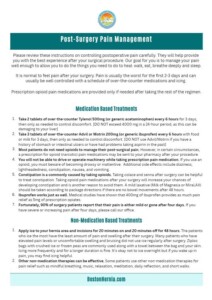If you’re preparing for hernia surgery, it’s completely normal to be concerned about what recovery will be like—especially when it comes to pain. In fact, pain is one of the most common worries patients have before surgery. The good news? With the right approach and preparation, hernia surgery doesn’t have to be very painful.
The amount of pain you experience after surgery can vary based on several factors, such as the type of surgery performed, the complexity of the hernia, the anesthesia used, some preexisting medical conditions, and your individual pain tolerance1,2.
How is pain managed after surgery?
At Boston Hernia, we tailor the surgical approach to your needs. When possible, we place mesh in the most optimal location using a technique that minimizes any trauma to your body. We also use local anesthetics (like lidocaine and bupivacaine) during surgery and provide thorough instructions and resources for a smooth recovery3-7.
Most patients manage pain well with over-the-counter medications like Tylenol (acetaminophen) and Motrin (ibuprofen). We also recommend using ice to minimize swelling and discomfort.
Will I need opioids?
In most cases, no. Over 90% of our patients recover without the need for opioid pain medications. We use a multimodal pain management strategy to help control discomfort while avoiding the common side effects of opioids, such as sleepiness, constipation, and the risk of addiction8-10.
What if over-the-counter medications aren’t enough?
Fewer than 10% of our patients report significant pain that interferes with sleep or mobility despite taking Tylenol and Motrin and using ice. For these individuals, we may prescribe a stronger pain medication to get them through the most difficult part of recovery.
Can I take Tylenol and Motrin together?
Yes, in most cases. We typically advise taking both every six hours—unless you have medical conditions that would make this unsafe11. Always check with your surgeon or primary care provider before starting any pain regimen.
What’s Boston Hernia’s approach to recovery?
Our goal is to make your recovery as smooth and pain-free as possible. We work closely with you to create a personalized plan that keeps your pain under control and gets you back to your normal routine quickly.
Disclaimer: the information on this page is for educational purposes only. It is not intended to diagnose, treat, or advise any medical treatment.
References
1. American College of Surgeons. (2020). Hernia Repair Patient Education. Retrieved from https://www.facs.org/
2. Perez AJ, et al. (2022). Predictors of low and high opioid tablet consumption after inguinal hernia repair: an ACHQC opioid reduction task force analysis. Hernia, 26(6):1625-1633. doi: 10.1007/s10029-022-02661-3.
3. Belyansky, I., et al. (2011). Prospective, comparative study of postoperative quality of life in laparoscopic, open, and robotic hernia repair. Surgical Endoscopy, 25(8), 2461–2464.
4. HerniaSurge Group. (2018). International guidelines for groin hernia management. Hernia, 22(1):1-165. doi: 10.1007/s10029-017-1668-x.
5. Reinhorn M, et al. (2023). Posterior mesh inguinal hernia repairs: a propensity score matched analysis of laparoscopic and robotic versus open approaches. Hernia, 27(1):93-104. doi: 10.1007/s10029-022-02680-0.
6. Agarwal D, et al. (2023). Improved patient-reported outcomes after open preperitoneal inguinal hernia repair compared to anterior Lichtenstein repair. Hernia, 27(5):1139-1154. doi: 10.1007/s10029-023-02852-6.
7. Bharani T, et al. (2024). Open preperitoneal inguinal hernia repair has superior 1-year patient-reported outcomes compared to Shouldice non-mesh repair. Hernia, 28(2):475-484. doi: 10.1007/s10029-023-02936-3.
8. Chou, R., et al. (2016). Management of Postoperative Pain: A Clinical Practice Guideline. The Journal of Pain, 17(2), 131–157.
9. Mylonas KS, et al. (2017). Patient-reported opioid analgesic requirements after elective inguinal hernia repair. Surgery, 162(5):1095-1100. doi: 10.1016/j.surg.2017.06.017.
10. Centers for Disease Control and Prevention (CDC). (2016). CDC Guideline for Prescribing Opioids for Chronic Pain. Retrieved from https://www.cdc.gov/drugoverdose/prescribing/guideline.html
11. Ong, C. K. S., et al. (2010). Combining paracetamol (acetaminophen) with nonsteroidal anti-inflammatory drugs: A qualitative systematic review of analgesic efficacy for acute postoperative pain. Anesthesia & Analgesia, 110(4), 1170–1179.

